When most people think of house painters Adelaide, their first thoughts go to color. But beyond selecting the perfect shade, texture plays a crucial role in the overall feel and design of a space. Adding texture to your walls can transform a flat, dull room into one that feels alive, dynamic, and full of character. Whether you’re using paint with added texture or employing different painting techniques, texture can dramatically enhance a room’s atmosphere. In this article, we’ll explore the importance of texture in painting, popular texturing methods, and how to use texture to add dimension to your walls.
1. Why Texture Matters in Interior Design
Texture adds a tactile quality to a space, making it more interesting and inviting. While color affects how a room looks, texture influences how it feels—both visually and physically. Smooth walls can create a clean, minimalist look, while textured walls add depth, warmth, and personality.
The use of texture in painting can also help solve practical design challenges. For example, textured walls can disguise imperfections such as cracks, dents, or uneven surfaces that might be more visible with smooth finishes. They can also help create a cozy, intimate vibe in larger rooms or make small spaces feel more interesting.
2. Popular Painting Techniques to Add Texture
There are several ways to introduce texture to your walls, and the right method depends on the look you’re trying to achieve. Here are some popular techniques:
- Sponging: Sponging is one of the easiest and most effective ways to add subtle texture to your walls. Using a natural sea sponge, paint is dabbed onto the surface, creating a soft, cloud-like effect. This method works well for adding depth without overpowering the room and can be done with either one or multiple colors for a more dramatic finish.
- Stippling: Stippling involves applying small, dotted patterns of paint using a brush, roller, or specialized stippling tool. This technique adds a fine texture to the walls, making them feel velvety to the touch. Stippling works well for achieving a uniform yet visually engaging surface, especially when using matte or low-sheen paints.
- Venetian Plaster: Venetian plaster is a more traditional texturing method that gives walls a polished, marble-like finish. Applied in layers, it is then burnished to create a high-shine, glossy surface. This technique adds a sense of luxury and elegance to a room and is particularly popular in Mediterranean-style homes.
- Limewash: Limewash offers a soft, chalky texture with a natural, rustic appeal. The paint is typically applied in thin layers, creating a beautifully weathered look. Limewash is perfect for spaces where you want to add an old-world charm, such as cottages or farmhouse-style interiors.
- Sand Texturing: For a bolder, more rugged look, sand can be added to the paint to create a gritty texture. Sand-textured walls are often found in outdoor spaces, hallways, or areas that require more durability. This method provides a high level of visual interest while being practical in heavy-use areas.
- Dry Brushing: Dry brushing is a technique where a nearly dry paintbrush is lightly dragged over a surface to create a streaked, textured effect. This method is great for creating a rustic, distressed look on walls or furniture and works especially well with light, neutral colors.
3. Choosing the Right Texture for Your Space
When selecting a texturing technique, it’s important to consider the overall feel of the room and the function of the space. In high-traffic areas, such as hallways or living rooms, more durable textures like sand texturing or Venetian plaster can add longevity as well as beauty.
For smaller, intimate spaces like bedrooms or study nooks, subtler textures like sponging or stippling can create a warm, inviting atmosphere. In bathrooms or kitchens, where moisture is a concern, limewash or Venetian plaster can be excellent choices because of their moisture-resistant properties.
Texture also pairs beautifully with color, and the two can work together to enhance the overall design. For example, a bold, vibrant color with a smooth finish can feel modern and sleek, while the same color with a textured finish can evoke a more traditional, rich feel.
4. The Maintenance of Textured Walls
While textured walls add depth and dimension, they may require a bit more maintenance than smooth surfaces. Dust and dirt can accumulate more easily in textured surfaces, so regular cleaning is necessary. A soft brush attachment on your vacuum or a microfiber cloth can help with maintenance. Additionally, if you need to touch up textured walls, it can be more challenging to match the original texture exactly.
Conclusion
Texture is an often overlooked but powerful element in painting that can bring dimension, warmth, and visual interest to your walls. Whether you choose to go for a bold, rugged texture or a subtle, soft finish, the use of texture can dramatically transform a room. By combining the right texturing techniques with complementary colors, you can create a space that feels not only visually engaging but also full of depth and character.




